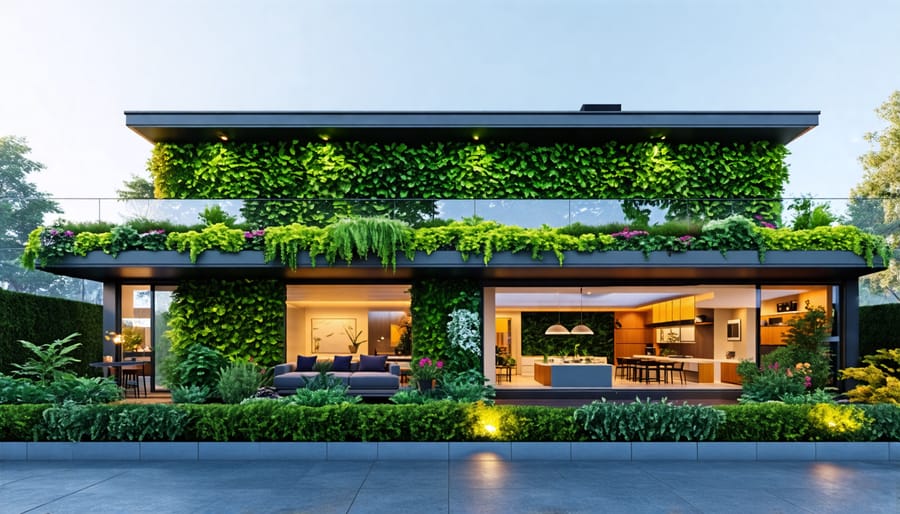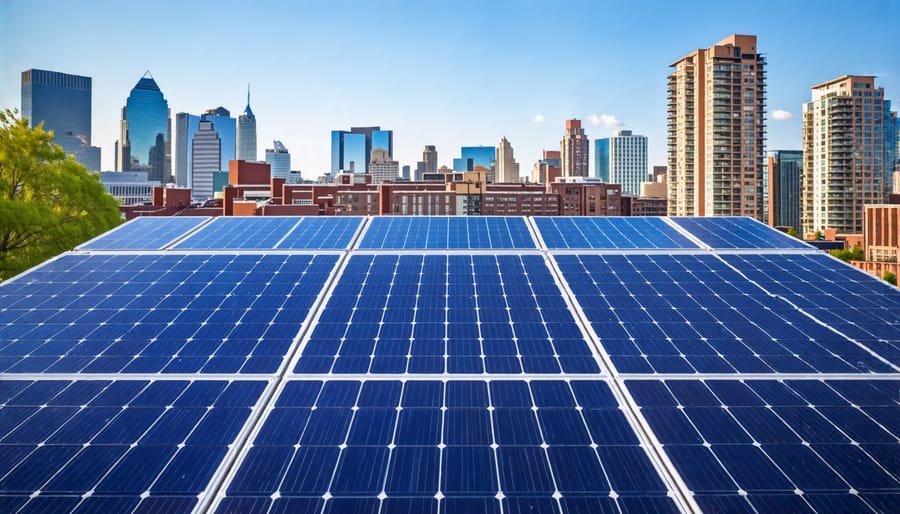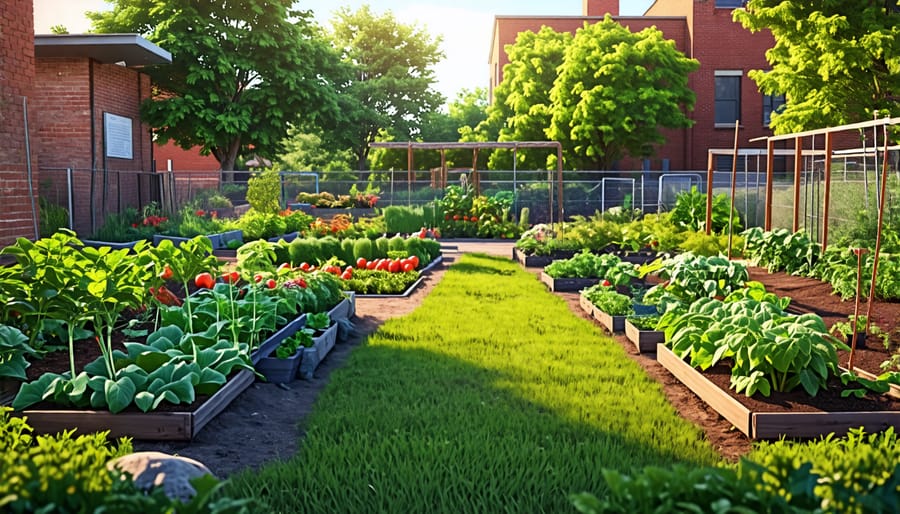Install energy-efficient lighting by replacing old bulbs with LED options, reducing energy consumption and cutting electricity bills. Integrate a rainwater harvesting system by setting up barrels to collect rain from your roof, providing a simple solution for garden and home use. Start composting kitchen scraps and yard waste to create a nutrient-rich fertilizer for your plants, contributing to waste reduction and soil health. Use sustainable materials for home improvements; opt for bamboo or reclaimed wood for flooring and furniture to embrace eco-friendly living by reducing carbon footprint. Educate household members on the importance of reducing water usage, such as taking shorter showers and fixing leaks promptly—increasing awareness fosters long-term sustainable habits. These practical actions exemplify urban sustainability, empowering you to transform your home into an eco-friendly haven.
Embracing Green Architecture
Eco-Friendly Building Materials
When it comes to creating a sustainable urban home, the choice of building materials can significantly impact your environmental footprint. One popular option is using recycled wood, which not only reduces the need for new timber but also gives your space a charming, rustic look. Instead of contributing to deforestation, you’re helping to respect and preserve our forests. Reclaimed wood can be used in a variety of projects, from flooring to custom furniture, bringing a unique story and texture to your home.
Similarly, bamboo is another eco-friendly choice that’s gaining popularity. It’s incredibly fast-growing and requires fewer resources to produce than traditional hardwoods, making it a great sustainable alternative. Its flexibility and strength make it ideal for everything from flooring to cabinetry. If you’re a DIY enthusiast looking to implement sustainable practices in your home, consider experimenting with these materials in your next project. They not only enhance the aesthetic appeal of your space but also support a more sustainable lifestyle.
Green Roofs and Living Walls
Imagine transforming your urban space into an oasis with green roofs and living walls! These innovations are becoming urban sustainability rockstars, enhancing landscapes while offering practical benefits. A stellar example is Chicago’s City Hall, where a green roof helps cool the building, reduce stormwater runoff, and improve air quality. This lush rooftop demonstrates the astounding potential of green spaces to blend function and beauty.
For DIY enthusiasts and renters, starting on a smaller scale is entirely feasible. Consider installing a living wall indoors or on a balcony. These vertical gardens not only add a vibrant visual element but also improve indoor air quality and provide sound insulation. Simple modular systems are widely available and can be a fun weekend project. Secure the structure, select your plants—like ferns or succulents—and watch your urban dwelling come to life.
Thinking of greening your roof? Explore options like intensive or extensive green roofs. While they require more structure support, they offer an expanded outdoor leisure area. Intensive roofs are lush and park-like, perfect for those with a green thumb. Extensive roofs, like those seen in urban eco-developments, are lighter and require less maintenance. With the right approach, your urban home can be a beacon of sustainability and style.

Energy Efficiency at Home
Solar Panels and Renewable Energy
Imagine a home powered by the sun—a living space that’s not only energy-efficient but also friendly to the wallet. In neighborhoods like Boulder, Colorado, and Austin, Texas, homeowners are turning to solar panels to harness renewable energy. Take, for instance, the Johnson family, who embraced solar energy to power their 3-bedroom home. They found that by installing solar panels, they cut their monthly electric bill by half while contributing to environmental sustainability.
For renters or those on a budget, consider DIY solar kits. These are increasingly popular for their affordability and ease of installation. Even small-scale projects, like solar chargers for garden lights or power banks for outdoor tools, can make a difference. The growing trend of community solar projects also allows participants to share solar power benefits without individual ownership of panels.
Incorporating solar energy is simpler than it seems and offers a practical start for those interested in boosting urban sustainability in their homes.

Smart Home Technology
In the realm of urban sustainability, smart home technology plays a pivotal role in enhancing energy efficiency. These devices, designed to make life more convenient, also offer significant environmental benefits. Consider smart thermostats, which learn your habits and adjust temperatures to reduce energy wastage—perfect for those environmental-conscious DIY enthusiasts. Meanwhile, smart lighting systems, activated by motion sensors or programmed schedules, ensure no light goes to waste, saving both energy and money.
For homeowners and renters alike, integrating smart plugs can be a game-changer. These allow you to monitor and control energy usage of various appliances right from your smartphone, making it easier to cut down on unnecessary consumption. Implementing these practical solutions supports sustainability efforts, reduces your carbon footprint, and, ultimately, contributes to a greener urban landscape. Dive into the world of smart home devices and watch how small changes lead to impactful results without any need for extensive renovations or expensive gadgets.
Water Conservation Practices
Rainwater Harvesting Systems
In urban settings, rainwater harvesting is becoming a staple of sustainable living, and it’s easier to implement than you might think. Homeowners and renters alike are setting up systems that capture rain from rooftops and channel it into barrels or underground storage for use in gardens, flushing toilets, or even laundry. Consider the example of Sarah, a DIY enthusiast in Brooklyn, who installed a simple system using repurposed food-grade barrels connected to her downspout. Not only does she save on water bills, but her lush garden thrives even in dry spells. For those interested in a larger scale setup, consult local experts or communities online dedicated to urban sustainability—they’re often buzzing with creative solutions and step-by-step guides on building cost-effective, eco-friendly systems right at home.
Low-Flow Fixtures and Appliances
Low-flow fixtures and appliances are game-changers in creating a sustainable urban home. By reducing water usage while maintaining performance, these technologies offer a smart, eco-friendly solution for homeowners and renters alike. Imagine saving gallons of water each day simply by switching to a low-flow showerhead or faucet. It’s not just about saving water; it’s about conserving energy and lowering your utility bills. Installation is often a straightforward DIY project, making it an attainable upgrade for those who like to roll up their sleeves. Expert tip: always check for the WaterSense label to ensure maximum efficiency. By incorporating these simple changes, you’re not only enhancing your home but also contributing to urban sustainability efforts. It’s a small change with a big impact, easy to implement and even easier to feel good about.
Urban Gardening and Green Spaces
Community Gardens
Community gardens offer a fantastic way for urban dwellers to embrace sustainability right in their neighborhoods. These gardens transform unused spaces into lush green areas that not only beautify the surroundings but provide fresh produce right at your doorstep. Imagine harvesting your own tomatoes or picking fresh herbs for dinner—this connection to food sources is both rewarding and practical. Community gardens foster a sense of camaraderie among neighbors, allowing many to learn new gardening skills from each other. For homeowners and renters alike, participating can be as simple as tending a small plot or helping with community events. They also offer a perfect opportunity to upcycle old items for plant beds, making it a great DIY project. Plus, growing your own veggies helps reduce your carbon footprint, making city life greener for everyone.

Balcony and Rooftop Gardens
Imagine transforming an overlooked urban corner into a flourishing oasis. Balcony and rooftop gardens offer an inspiring example of urban sustainability. Take the creative endeavors of citizens in Toronto, where the rooftop garden atop the Fairmont Royal York hotel showcases vibrant herbs and vegetables providing fresh produce for its restaurants. In Berlin, the Prinzessinnengärten transforms rooftops into thriving community plots, sprouting kale and tomatoes in repurposed containers. These projects not only green urban spaces but also reduce heat and pollution, capturing rainwater and improving air quality. Want to start your own? Begin by selecting lightweight pots and easy-to-grow plants like herbs. Ensure structural integrity and consider lightweight soil mixes. As you nurture nature above ground, you’ll appreciate the rewards of a personal green retreat in your concrete jungle.
Conclusion
Embracing urban sustainability in your home may seem daunting at first, but it’s actually an exciting opportunity to contribute to a healthier planet while also enhancing your living space. Throughout this article, we’ve explored practical steps and inspiring examples that make sustainable living accessible to everyone, whether you’re a homeowner, renter, or a DIY enthusiast. From energy-efficient upgrades to utilizing eco-friendly materials and choosing sustainable décor choices, small changes can lead to significant impacts.
We’ve discussed simple methods like using smart thermostats to reduce energy consumption and collecting rainwater for gardening, which not only save resources but also cut costs—a win-win for your home and the environment. By adopting these practices, you’re not only taking advantage of innovative solutions but also investing in a future where sustainability is the norm.
So, why not start today? Begin integrating some of these practices in your daily life and reap the benefits of a greener lifestyle. Share your journey with others to inspire and be inspired. Remember, every little step counts, and together we can make a lasting, positive change. Sustainability is more than a trend; it’s a responsibility and an opportunity for mindful living that starts at home.
